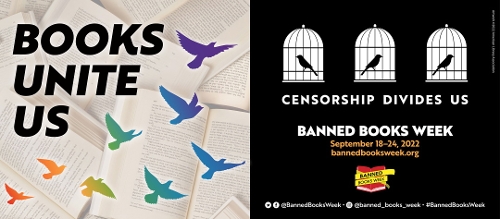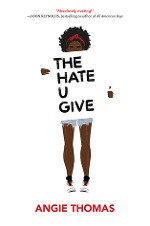
Find more great Horn Book content at these links:
Recommended books: reviews and themed booklists
App and e-book reviews
Movie reviews
Event news and recaps
Events calendar
Banned Books Week 2022
It’s Banned Books Week! From The American Library Association’s website: “ALA's Office for Intellectual Freedom (OIF) receives reports from libraries, schools, and the media on attempts to ban books in communities across the country. We compile lists of challenged books in order to inform the public about censorship efforts that affect libraries and schools.” This year's theme is "Books Unite Us. Censorship Divides Us."

It’s Banned Books Week!
From The American Library Association’s website: “ALA's Office for Intellectual Freedom (OIF) receives reports from libraries, schools, and the media on attempts to ban books in communities across the country. We compile lists of challenged books in order to inform the public about censorship efforts that affect libraries and schools.”
This year's theme is "Books Unite Us. Censorship Divides Us."
Two years ago ALA also released a list of the Top 100 Most Banned and Challenged Books of the Decade. Look for Banned Books Week events in your area to get involved. And don't miss reading Adrienne L. Pettinelli's "Field Notes: The Day the Book Banners Came for Us" (from the new September/October 2022 Horn Book Magazine) and Pat Scales's "What Makes a Good Banned Book?" (from the September/October 2009 Horn Book Magazine).
Based on 729 challenges (and with "total book challenges in 2022 set to exceed 2021 record"), here are the top ten most challenged books of 2021.
- Gender Queer by Maia Kobabe
Reasons: Banned, challenged, and restricted for LGBTQIA+ content and because it was considered to have sexually explicit images - Lawn Boy by Jonathan Evison
Reasons: Banned and challenged for LGBTQIA+ content and because it was considered to be sexually explicit - All Boys Aren’t Blue by George M. Johnson
Reasons: Banned and challenged for LGBTQIA+ content and profanity and because it was considered to be sexually explicit - Out of Darkness by Ashley Hope Perez
Reasons: Banned, challenged, and restricted for depictions of abuse and because it was considered to be sexually explicit - The Hate U Give by Angie Thomas
Reasons: Banned and challenged for profanity and violence and because it was thought to promote an anti-police message and indoctrination of a social agenda - The Absolutely True Diary of a Part-Time Indian by Sherman Alexie
Reasons: Banned and challenged for profanity, sexual references, and use of a derogatory term - Me and Earl and the Dying Girl by Jesse Andrews
Reasons: Banned and challenged because it was considered sexually explicit and degrading to women - The Bluest Eye by Toni Morrison
Reasons: Banned and challenged because it depicts child sexual abuse and was considered sexually explicit - This Book is Gay by Juno Dawson
Reasons: Banned, challenged, relocated, and restricted for providing sex education and LGBTQIA+ content - Beyond Magenta by Susan Kuklin
Reasons: Banned and challenged for LGBTQIA+ content and because it was considered to be sexually explicit.
Here’s how the Horn Book reviewed 2021's most challenged children’s and young adult books:
 Out of Darkness
Out of Darkness
by Ashley Hope Perez
High School Carolrhoda Lab 402 pp.
9/15 978-1-4677-4202-3 $18.99
e-book ed. 978-1-4677-6179-6
Two teens, Mexican American Naomi and African American Wash, fall in love and struggle to keep their relationship secret in racist 1936 east Texas. This novel weaves in the forces that led up to the 1937 New London school explosion, a tragedy rooted in the era's violent abuse against minorities. A poignant, potent, and provocative historical drama steeped in well-researched factual details. RITA SOLTAN
From the Guide/Reviews Database.

![]() The Hate U Give
The Hate U Give
by Angie Thomas
High School Balzer + Bray/HarperCollins 453 pp.
2/17 978-0-06-249853-3 $17.99
Sixteen-year-old Starr Carter lives a life many African American teenagers can relate to: a life of double consciousness. Caught between her rough, predominantly black neighborhood and the “proper,” predominantly white prep school she attends, Starr has learned how to “speak with two different voices and only say certain things around certain people.” This precarious balance is broken when Starr witnesses the shooting of her (unarmed) childhood friend Khalil at the hands of a police officer. What follows is a gut-wrenching chain of events that alters all Starr holds dear. New relationships are forged, old ones are severed, and adversaries arise as Starr’s family, friends, school, and neighborhood react to Khalil’s death, including questioning who Khalil was, and whether his death was justified. Between her neighborhood’s “no-snitching” code and inaccurate media portrayals, Starr must decide whether or not to speak out — and her decision could endanger her life. With a title taken from rapper Tupac Shakur’s acronym THUG LIFE (“The Hate U Give Little Infants Fucks Everybody”), the novel introduces numerous components of the urban experience, “thug life” included. From drug addicts to police officers, most characters are multifaceted, proving that Starr’s world is not all black or white (or black vs. white, for that matter). The story, with so many issues addressed, can feel overwhelming at times, but then again, so can the life of an African American teen. Debut author Thomas is adept at capturing the voices of multiple characters, and she ultimately succeeds in restoring Starr’s true voice. Thomas has penned a powerful, in-your-face novel that will similarly galvanize fans of Kekla Magoon’s How It Went Down (rev. 11/14) and Jason Reynolds and Brendan Kiely’s All American Boys (rev. 11/15). EBONI NJOKU
From the March/April 2017 issue of The Horn Book Magazine.

![]() The Absolutely True Diary of a Part-Time Indian
The Absolutely True Diary of a Part-Time Indian
by Sherman Alexie; illus. by Ellen Forney
Middle School, High School Little 232 pp.
9/07 978-0-316-01368-0 $16.99 g
The line between dramatic monologue, verse novel, and standup comedy gets unequivocally — and hilariously and triumphantly — bent in this novel about coming of age on the rez. Urged on by a math teacher whose nose he has just broken, Junior, fourteen, decides to make the iffy commute from his Spokane Indian reservation to attend high school in Reardan, a small town twenty miles away. He’s tired of his impoverished circumstances (“Adam and Eve covered their privates with fig leaves; the first Indians covered their privates with their tiny hands”), but while he hopes his new school will offer him a better education, he knows the odds aren’t exactly with him: “What was I doing at Reardan, whose mascot was an Indian, thereby making me the only other Indian in town?” But he makes friends (most notably the class dork Gordy), gets a girlfriend, and even (though short, nearsighted, and slightly disabled from birth defects) lands a spot on the varsity basketball team, which inevitably leads to a showdown with his own home team, led by his former best friend Rowdy. Junior’s narration is intensely alive and rat-a-tat-tat with short paragraphs and one-liners (“If God hadn’t wanted us to masturbate, then God wouldn’t have given us thumbs”). The dominant mode of the novel is comic, even though there’s plenty of sadness, as when Junior’s sister manages to shake off depression long enough to elope — only to die, passed out from drinking, in a fire. Junior’s spirit, though, is unquenchable, and his style inimitable, not least in the take-no-prisoners cartoons he draws (as expertly depicted by comics artist Forney) from his bicultural experience. ROGER SUTTON
From the September/October 2007 issue of The Horn Book Magazine.
 Me and Earl and the Dying Girl
Me and Earl and the Dying Girl
by Jesse Andrews
High School Amulet/Abrams 298 pp.
3/12 978-1-4197-0176-4 $16.95
"For me personally, things are in no way more meaningful because I got to know Rachel before she died. If anything, things are less meaningful." Self-deprecating and cynical in the extreme, high school senior Greg says he's writing the opposite of a "sappy tear-jerking" cancer story and offers up a funny, profane, and, despite his supposed best efforts, poignant narrative. CHRISTINE M. HEPPERMANN
From the Guide/Reviews Database.
Read more about Toni Morrison here.
 Beyond Magenta: Transgender Teens Speak Out
Beyond Magenta: Transgender Teens Speak Out
by Susan Kuklin
High School Candlewick 182 pp.
2/14 978-0-7636-5611-9 $22.99
e-book ed. 978-0-7636-7035-1 $22.99
Rather than attempting to convey the spectrum of transgender experience through a multitude of voices, Kuklin tries something different here, focusing on just six young people whose gender identity is something other than what it was labeled at birth. All six take gender-altering hormones; four were birth-designated male and two female, but in all cases there is no confusion about who they are now. Christina, born Matthew, looks forward to a complete transition (“It would be so great if I could get an operation, if I could get my vagina”), while Cameron says, “I like to be recognized as not a boy and not a girl. I’m gender queer, gender fluid, and gender other.” In her edited transcriptions of the interviews, Kuklin lets her subjects speak wholly for themselves, and while their bravery is heartening, their bravado can be heartbreaking. But who expects teenagers to be tentative? Photographs (of most of the subjects) are candid and winning; and appended material, including Kuklin’s explanation of her interview process, a Q&A with the director of a clinic for transgendered teens, and a great resource list, is valuable. ROGER SUTTON
From the March/April 2014 issue of The Horn Book Magazine.
Which banned books are you reading this week?
RELATED
ALREADY A SUBSCRIBER? LOG IN
We are currently offering this content for free. Sign up now to activate your personal profile, where you can save articles for future viewing.







Add Comment :-
Be the first reader to comment.
Comment Policy:
Comment should not be empty !!!